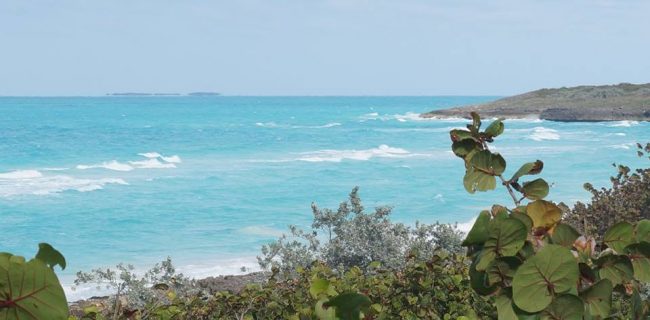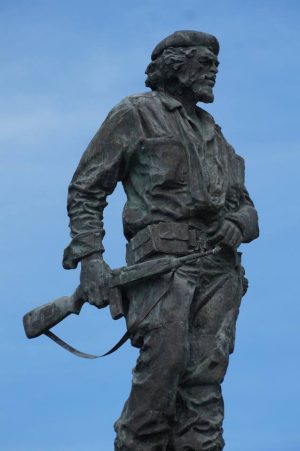A swarm of fish—including a host of yellow and black striped sergeant majors—make the water boil around my girlfriend, Stella, as she snorkels and strews cracker crumbs into the waters off Cayo Santa Maria. This part of Cuba, north-central, boasts some of the most beautiful beaches on this historic island, as well as great snorkeling. We are staying at the Hotel Cayo Santa Maria (formally the Eurostar, but now managed by Cuba’s tourism agency, Gaviota). Our room is a lovely junior suite, which directly overlooks the ocean. All we can see from our balcony is sun, sand, sea, and tropical vegetation, with the ocean only meters from our door.
 The white, powder-sand beach of this resort is punctuated on either side by volcanic ledges that make for some good fish spotting, but the best way to enjoy this sport is to take a catamaran trip to more protected waters. This vessel makes a side-trip to an isolated cove, where you can get “up-close-and-personal” with Cuba’s fishy denizens…by donning a mask and fins! As a side bonus, the boat also makes a stop at a “delphinarium”, where visitors can pat and even kiss these smooth-skinned and sociable cetaceans. The trip includes all admissions, lunch, and unlimited drinks (though if you “over-indulge”, they won’t let you snorkel or go near the porpoises). Decadents beware.
The white, powder-sand beach of this resort is punctuated on either side by volcanic ledges that make for some good fish spotting, but the best way to enjoy this sport is to take a catamaran trip to more protected waters. This vessel makes a side-trip to an isolated cove, where you can get “up-close-and-personal” with Cuba’s fishy denizens…by donning a mask and fins! As a side bonus, the boat also makes a stop at a “delphinarium”, where visitors can pat and even kiss these smooth-skinned and sociable cetaceans. The trip includes all admissions, lunch, and unlimited drinks (though if you “over-indulge”, they won’t let you snorkel or go near the porpoises). Decadents beware.
The largest island of the Caribbean, Cuba boasts a population of 11 million. 2.5 million are ensconced in the western portion of the northern coast in the capital city of Havana. The vibrant capital, however, is far away from here. Indeed, you must traverse in-excess-of forty causeways just to get to our hotel.
The more westerly pool at the Hotel Cayo Santa Maria (or just “the Cayo”) attracts a younger population with its frenetic music and activities, while the easterly pool hosts a more sedate crowd. But, those bent on real tranquility can haul a towel and beach chair up the long beach to areas where the only sound you’ll hear is the crashing of the surf and the cries of the seagulls.
Food is plentiful and there’s lots of fresh fruit and seafood. Generally, the cuisine in Cuba is pretty basic; consequently, dedicated foodies might want to look elsewhere. Hotel staff are warm and friendly. Commodities like nail polish, soap, cosmetics, pencils and pens are in short supply for them, so rather than money, we chose to leave these as tips for maids and other staff. The result…elaborate towel animals and sculptures on our bed each morning…sort of “origami in cloth”.
 If you are interested in history, there is a fascinating day tour to Santa Clara, where you can visit the impressive monument and mausoleum, as well as a museum dedicated to Cuba’s hero, Che Guevara. This Argentinian physician befriended Fidel Castro at a young age and assisted him in the 1957 revolution, which overthrew dictator Batista. Guevara died in 1967 while attempting to incite revolution in Bolivia. He became somewhat of an icon for the hippy and anti-war movement of the 1960’s and his beret-clad image was frequently seen on T-shirts in my university days. Many of his personal effects, including pistols and automatic rifles, are on display. I didn’t see any medical instruments; but there is a photo of him playing golf (in his fatigues and beret) so some of the medical training must have stuck!
If you are interested in history, there is a fascinating day tour to Santa Clara, where you can visit the impressive monument and mausoleum, as well as a museum dedicated to Cuba’s hero, Che Guevara. This Argentinian physician befriended Fidel Castro at a young age and assisted him in the 1957 revolution, which overthrew dictator Batista. Guevara died in 1967 while attempting to incite revolution in Bolivia. He became somewhat of an icon for the hippy and anti-war movement of the 1960’s and his beret-clad image was frequently seen on T-shirts in my university days. Many of his personal effects, including pistols and automatic rifles, are on display. I didn’t see any medical instruments; but there is a photo of him playing golf (in his fatigues and beret) so some of the medical training must have stuck!
Afterwards, enjoy the picturesque colonial square and gardens of 16th Century Remedios. Be sure to pop into the church and see its elaborate, gilded altar, then cruise the square and enjoy 1950’s era vintage cars.
 There is much more to Cuba than just sun and sand, and the island is once more starting to open up to an American clientèle—the first time in almost 60 years. It will be interesting to see what changes this brings. At present, the predominant tourist presence is Canadians, such as myself. I suppose, however, we will soon be sharing the aged Havana Club Rum, Cohiba cigars, and beaches with our southern neighbors.
There is much more to Cuba than just sun and sand, and the island is once more starting to open up to an American clientèle—the first time in almost 60 years. It will be interesting to see what changes this brings. At present, the predominant tourist presence is Canadians, such as myself. I suppose, however, we will soon be sharing the aged Havana Club Rum, Cohiba cigars, and beaches with our southern neighbors.
Photo Credit
All photos courtesy of Stella van der Lugt—All rights reserved.


Please Share Your Thoughts - Leave A Comment!